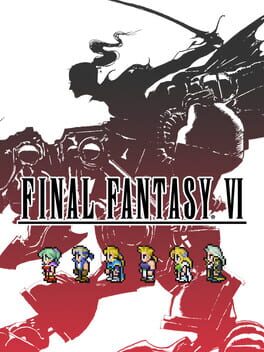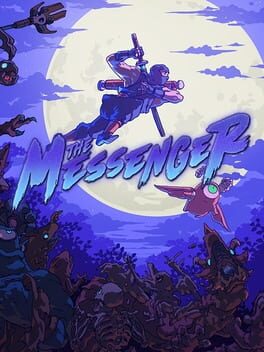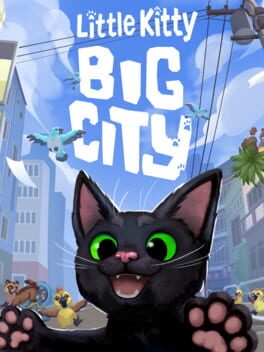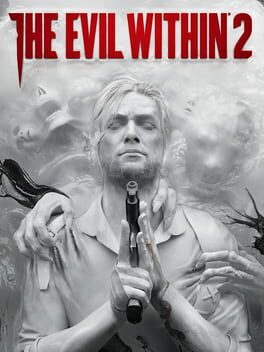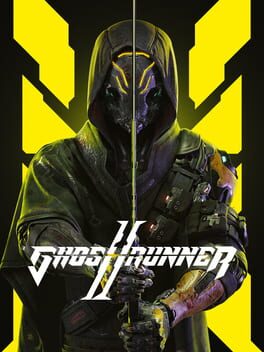Jerrett
Bio
Hi please stop stalking me thanks
I'm a figment of your imagination
2 or below - bad
2.5-3.5 - good
4-4.5 - amazing
5 - pinnacle of its genre
Hi please stop stalking me thanks
I'm a figment of your imagination
2 or below - bad
2.5-3.5 - good
4-4.5 - amazing
5 - pinnacle of its genre
Badges

Roadtrip
Voted for at least 3 features on the roadmap

Liked
Gained 10+ total review likes

N00b
Played 100+ games

Best Friends
Become mutual friends with at least 3 others

Noticed
Gained 3+ followers
Favorite Games
201
Total Games Played
010
Played in 2024
000
Games Backloggd
Recently Played See More
Recently Reviewed See More
The Evil Within 2 starts on a thunderous note. You start the game by reliving the worst day of the main character's, Sebastian Castellanos, life--the day he lost his daughter in a fire. After that sequence, Sebastian wakes up at a bar, and we see Kidman. She tells us that Sebastian's daughter, Lily, didn't die, but she is actually being used in Mobius' newest iteration of STEM. After some back and forth and some physical altercations, Sebastian is transported to STEM to save his daughter. Throughout the game, you meet multiple members of Mobius as well as the two main antagonists--Stefano and Theodore. The villains are a true highlight. Stefano is obsessed with art, and Theodore is obsessed with past trauma. The sections of the game right before fighting the villains might be my favorite parts. Destroying Stefano's art and reliving the highlights of The Evil Within will be the parts of the game I remember most fondly. The story kept me interested throughout its runtime, but it could've went so much further. I think there could have been a few more side quests to really flesh out each of the members of the supporting cast. The side quests that are present are great. They add so much to the story and the relationship you build with the characters, so I would have loved to have more side content focused on the side characters.
Gameplay was the main issue I had with The Evil Within, and the sequel addressed most of my complaints. The addition of the open world areas was an incredible idea. The crafting here is pretty simple. Ammo needing more resources when you're not at a weapon bench leans into the idea that you should be restrained in survival horror games. It gets you thinking, "Should I craft more handgun ammo right now? But it takes less at benches. Then again, if I run to a bench I may use ammo when killing an enemy, so would it be worth it? Maybe I'll get an ammo drop soon." Those thoughts lingered during the 13 hours it took me to finish The Evil Within 2 along with all of its side content and finding most of the collectibles. The main complaint that stayed in the sequel is that the camera is still way too close to Sebastian's back. I get that having it close to him gives a more intimate experience and makes it more claustrophobic, but widening the FOV and pulling the camera back a little bit wouldn't hurt.
The Evil Within 2 is one of the greatest survival horror games of the PS4/XONE generation. Launching in 2017, TEW2 fixed most of the problems that many people--including myself--had with the original, but it keeps some aspects of the original that could have been altered to produce an even better game. The Evil Within 2 stands alongside the greats of the genre by introducing mechanics that should not be forgotten, but they barely miss the landing by having a story that could have been so much more. The story is not bad, but it has so much unused potential. I'm sure a sequel would have been even better, but, unfortunately, we will never get a sequel because of Tango's recent closure.
Gameplay was the main issue I had with The Evil Within, and the sequel addressed most of my complaints. The addition of the open world areas was an incredible idea. The crafting here is pretty simple. Ammo needing more resources when you're not at a weapon bench leans into the idea that you should be restrained in survival horror games. It gets you thinking, "Should I craft more handgun ammo right now? But it takes less at benches. Then again, if I run to a bench I may use ammo when killing an enemy, so would it be worth it? Maybe I'll get an ammo drop soon." Those thoughts lingered during the 13 hours it took me to finish The Evil Within 2 along with all of its side content and finding most of the collectibles. The main complaint that stayed in the sequel is that the camera is still way too close to Sebastian's back. I get that having it close to him gives a more intimate experience and makes it more claustrophobic, but widening the FOV and pulling the camera back a little bit wouldn't hurt.
The Evil Within 2 is one of the greatest survival horror games of the PS4/XONE generation. Launching in 2017, TEW2 fixed most of the problems that many people--including myself--had with the original, but it keeps some aspects of the original that could have been altered to produce an even better game. The Evil Within 2 stands alongside the greats of the genre by introducing mechanics that should not be forgotten, but they barely miss the landing by having a story that could have been so much more. The story is not bad, but it has so much unused potential. I'm sure a sequel would have been even better, but, unfortunately, we will never get a sequel because of Tango's recent closure.
The Messenger is of a select few metroidvanias that I have cared enough to complete. So many games in this genre don't do anything for me---which is weird because I enjoy all of the elements of metroidvanias. The interconnected world, power-ups, progression... each part on their own is great, but I feel like more often than not things get a little hazy when they are put together. Maybe it's just a skill issue on my part, but I couldn't care less.
The Messenger combats my problems with metroidvanias by it not being a metroidvania until halfway through the game. You start out with 8-bit visuals, combat, and game conventions to ease your way into the game. When The Messenger is like this, it plays like an old Ninja Gaiden game. Learning the game's mechanics this way lets each of them breath, and it never got overwhelming. Eventually, the game turns 16-bit and starts showing off its metroidvania side. Everything mentioned earlier gets an upgrade that you can feel while playing. The music changes, the pixel art starts looking more like a SNES game rather than one from the NES, and the levels start becoming more ambitious. Soon after that, though, the game pulls out its Trump card: switching between 8- and 16-bit.
When switching between these two in each level, your knowledge of each gameplay style is tested. You'll go from relatively simple areas while in the 8-bit world and then, upon switching to the 16-bit version of the level, everything gets taken up a notch. You do this multiple times per level, and each time is more inventive than the last.
The Messenger's main gameplay systems is its combat and platforming. The platforming is great, and it can get pretty challenging at times too. The combat is simple, but it can get pretty involved. The Messenger is at its best during boss fights when it tests you on both your platforming and combat abilities.
The writing is great too. It made me laugh multiple times during my playthroughs, and the characters are all great. It never falls into the side of annoyance with any of the side characters--they all have a unique charm to them that I feel like is only really ever seen in Nintendo games.
The Messenger takes the best parts of being a side-scroller NES game and being a contemporary metroidvanias to make an experience that is unforgettable.
The Messenger combats my problems with metroidvanias by it not being a metroidvania until halfway through the game. You start out with 8-bit visuals, combat, and game conventions to ease your way into the game. When The Messenger is like this, it plays like an old Ninja Gaiden game. Learning the game's mechanics this way lets each of them breath, and it never got overwhelming. Eventually, the game turns 16-bit and starts showing off its metroidvania side. Everything mentioned earlier gets an upgrade that you can feel while playing. The music changes, the pixel art starts looking more like a SNES game rather than one from the NES, and the levels start becoming more ambitious. Soon after that, though, the game pulls out its Trump card: switching between 8- and 16-bit.
When switching between these two in each level, your knowledge of each gameplay style is tested. You'll go from relatively simple areas while in the 8-bit world and then, upon switching to the 16-bit version of the level, everything gets taken up a notch. You do this multiple times per level, and each time is more inventive than the last.
The Messenger's main gameplay systems is its combat and platforming. The platforming is great, and it can get pretty challenging at times too. The combat is simple, but it can get pretty involved. The Messenger is at its best during boss fights when it tests you on both your platforming and combat abilities.
The writing is great too. It made me laugh multiple times during my playthroughs, and the characters are all great. It never falls into the side of annoyance with any of the side characters--they all have a unique charm to them that I feel like is only really ever seen in Nintendo games.
The Messenger takes the best parts of being a side-scroller NES game and being a contemporary metroidvanias to make an experience that is unforgettable.
When it comes to games I play nowadays, they have to hook me relatively quickly for me to play them all the way through. This part about my playing habits is especially true for soulslikes. I am of the opinion that VERY few games can approach FromSoftware's souls games in terms of quality. Prior to finishing Lies of P, the only game that ever came close was Nioh 2. Lies of P now joins Nioh 2 in being the only two soulslikes that are up there with FromSoftware.
Lies of P feels more like a FromSoftware game than any other soulslike I've ever played. The combat, world design, music, and (something I rarely see mentioned in games like this) cutscene direction feel, sound, and look like FromSoftware made them. If your basis on how good a soulslike is completely based on how alike it is to games that FromSoftware make, then this will be your favorite without a doubt. I still think Nioh 2 is the best soulslike because of how it evolves the formula (read my Nioh 2 review for more!), but this is an excellent beginning for a studio that only had one other game under their belt prior to this.
The most important parts of soulslikes are level design and combat. Despite being important to how these games feel and play, many soulslikes are not able to nail either of them; however, Lies of P succeeds in both of these (albeit to varying degrees). Lies of P understands soulslike combat better than most soulslikes that have emerged since the genres inception. The team at Round 8 gets the intricacies of what makes these games feel so good to play. The cool boss fights and flashy moves are not what people play these games for (or at least it's not what I play them for). This isn't me undermining the game's bosses--most of them are incredible, but some are laughably bad (Black Rabbit Brotherhood and Victor). Sure, they both play a part, but the build customization and encounters are what make these games shine. Each of the main parts (combat, presentation, bosses, story) need to work together to create an experience. If even one part is bad, it sours the experience.
Being able to take apart most weapons is amazing. Looking at each blade's move set and damage with different handles was something I constantly looked forward to each time I found a new weapon. It really leans into the idea that all weapons and playstyles are valid--which is something we haven't seen in this genre since Bloodborne. I also enjoy that it marries the aggression of Bloodborne with the parrying mechanics of Sekiro. The only downside to this is that I feel that the parry window is just barely too tight. The enemy encounters in each of its levels are mostly well thought out, but some encounters feel unfair to an extent. I think level design is Lies of P's main flaw. These levels are NOT bad (barring Collapsed Krat), but they don't have any of the inventiveness that FromSoftware titles have. I feel like this is completely due to the game's linearity. It doesn't really feel like you're making your way through a world, but it instead feels like you are going through the motions.
The music, art direction, and cutscenes are also a standout. Each of these stand toe-to-toe with FromSoftware's best. I think the records you collect have some of the most beautiful arrangements this genre has to offer. Bloodborne is an easy comparison to make here, but I think Demon's Souls also has a say here with the Shrine of Storm and Tower of Latria feel like heavy inspirations for Lies of P's art direction. And now there are the cutscenes. The cutscenes that introduce each of the game's main bosses as well as major story beats are incredible too. I can't really describe why I feel so drawn to the cutscenes here--I haven't actively thought about any other soulslike's cutscenes before--but the ones here just jump out at me as well made.
Saying that Lies of P is just an imitation of FromSoftware's work with a Pinocchio spin really discredits a lot of what Lies of P does right, but I can understand where it is coming from. Lies of P wears its inspirations on its ever-growing nose, but it can stand on its own as something truly remarkable.
Lies of P feels more like a FromSoftware game than any other soulslike I've ever played. The combat, world design, music, and (something I rarely see mentioned in games like this) cutscene direction feel, sound, and look like FromSoftware made them. If your basis on how good a soulslike is completely based on how alike it is to games that FromSoftware make, then this will be your favorite without a doubt. I still think Nioh 2 is the best soulslike because of how it evolves the formula (read my Nioh 2 review for more!), but this is an excellent beginning for a studio that only had one other game under their belt prior to this.
The most important parts of soulslikes are level design and combat. Despite being important to how these games feel and play, many soulslikes are not able to nail either of them; however, Lies of P succeeds in both of these (albeit to varying degrees). Lies of P understands soulslike combat better than most soulslikes that have emerged since the genres inception. The team at Round 8 gets the intricacies of what makes these games feel so good to play. The cool boss fights and flashy moves are not what people play these games for (or at least it's not what I play them for). This isn't me undermining the game's bosses--most of them are incredible, but some are laughably bad (Black Rabbit Brotherhood and Victor). Sure, they both play a part, but the build customization and encounters are what make these games shine. Each of the main parts (combat, presentation, bosses, story) need to work together to create an experience. If even one part is bad, it sours the experience.
Being able to take apart most weapons is amazing. Looking at each blade's move set and damage with different handles was something I constantly looked forward to each time I found a new weapon. It really leans into the idea that all weapons and playstyles are valid--which is something we haven't seen in this genre since Bloodborne. I also enjoy that it marries the aggression of Bloodborne with the parrying mechanics of Sekiro. The only downside to this is that I feel that the parry window is just barely too tight. The enemy encounters in each of its levels are mostly well thought out, but some encounters feel unfair to an extent. I think level design is Lies of P's main flaw. These levels are NOT bad (barring Collapsed Krat), but they don't have any of the inventiveness that FromSoftware titles have. I feel like this is completely due to the game's linearity. It doesn't really feel like you're making your way through a world, but it instead feels like you are going through the motions.
The music, art direction, and cutscenes are also a standout. Each of these stand toe-to-toe with FromSoftware's best. I think the records you collect have some of the most beautiful arrangements this genre has to offer. Bloodborne is an easy comparison to make here, but I think Demon's Souls also has a say here with the Shrine of Storm and Tower of Latria feel like heavy inspirations for Lies of P's art direction. And now there are the cutscenes. The cutscenes that introduce each of the game's main bosses as well as major story beats are incredible too. I can't really describe why I feel so drawn to the cutscenes here--I haven't actively thought about any other soulslike's cutscenes before--but the ones here just jump out at me as well made.
Saying that Lies of P is just an imitation of FromSoftware's work with a Pinocchio spin really discredits a lot of what Lies of P does right, but I can understand where it is coming from. Lies of P wears its inspirations on its ever-growing nose, but it can stand on its own as something truly remarkable.



